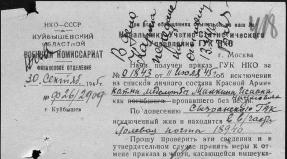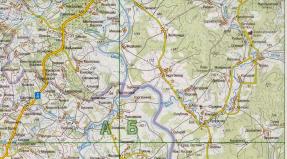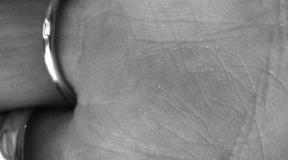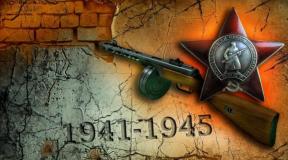Flags of the ussr navy. Flag of the ussr navy and its history Soviet naval flag history
The naval flag of Russia was approved on July 21, 1992 and is regulated by the naval charter of the Russian Navy.
The flag is a rectangular white cloth with a dark blue St. Andrew's cross.
The flag has an aspect ratio of 2: 3.
The flag of the Russian Navy is included in the State Heraldic Register of the Russian Federation at number 6.
The flag symbolizes the nationality of the ship, as well as the readiness to defend the interests of Russia in the water.
The flag is similar to the flag of Scotland. In fact, the flags are inverted versions of each other, although it is known that the flag of Scotland appeared before the flag of the Russian Navy.
The flag has been in use since the early 18th century. Peter the First made eight sketches (projects) of the flag. Description of the eighth draft flag: " The flag is white, across it there is a blue St. Andrew's cross, with which he christened Russia". Thus, the flag takes its origin from the period 1699-1712 until 1917.
After 1917, the flag with the St.Andrew's Cross was not used on the territory of the RSFSR and the USSR.
St. Andrew's flag in religious institutions
Flags of the Russian Navy are located in the Naval Nikolsky Cathedral, located in the city of Kroshtadt.
The Naval Nikolsky Cathedral was conceived as a temple and as a monument to all the dead sailors of Russia. Inside the temple are black and white boards made of marble. The black ones bear the names of officers who died in combat, as well as in the line of duty; the lower naval ranks are not located by name, they were placed in total, excluding those who performed the feat. On the white marble boards were the names of the clergy who served on the ships of the Navy and who died on the water.
Historical flags of the Russian Navy

Flags of the Soviet Navy
The flag was approved on May 27, 1935 and canceled on July 26, 1992. The flag was a rectangular cloth with a horizontal blue stripe at the bottom of the flag. Closer to the shaft was a five-pointed red star. On the other side was a crossed red hammer and sickle. The flag had an aspect ratio of 2: 3. During the existence of the USSR, the flag of the USSR Navy was changed three times.
Historical naval flags of the USSR



Sources of
- Naval ship charter. Chapter 15.
- Ship charter of the USSR Navy.
- Order for the fleet of September 11, 1923
- Order of the Revolutionary Military Council of the Republic of September 6, 1923 No. 1981.
- Federal Law of December 29, 2000 No. 162-FZ "On the Banner of the Armed Forces of the Russian Federation, the Banner of the Navy, the Banners of Other Services of the Armed Forces of the Russian Federation and the Banners of Other Troops".
- Decree of the President of the Russian Federation of July 21, 1992 No. 798 "On naval flags and pennants of the Russian Federation".
- Photos belong to the website portal.
USSR Navy (USSR Navy)- the naval fleet of the Union of Soviet Socialist Republics that existed from 1918 to 1992, created on the basis after the October Revolution. In 1918-1924 and 1937-1946 it bore the name Workers 'and Peasants' Red Fleet (RKKF); in 1924-1937 and 1950-1953 - Naval Forces of the Workers 'and Peasants' Red Army (Red Army Navy).
Creation of a fleet
The Soviet Navy was created from the remnants of the Russian Imperial Navy, which was almost completely destroyed as a result of the October Revolution and the Civil War.
During the revolution, sailors left their ships en masse, and officers were partially repressed or killed, partially joined the White movement or resigned. Work on the construction of the ships was stopped.
The battleships of the "Soviet Union" type were supposed to become the basis of the naval power of the Soviet fleet, and the construction of a modern fleet was one of the priority tasks of the USSR, but the outbreak of the Great Patriotic War prevented the implementation of these plans.
The workers 'and peasants' Red Fleet took part in the Soviet-Finnish war of 1939-1940, which came down mainly to artillery duels between Soviet ships and Finnish coastal fortifications.
The Second World War
In 1941, as a result of the attack by the Nazi German army on the Soviet Union, the Soviet army suffered huge losses, many sailors were transferred to the ground forces, and naval guns were removed from ships and turned into coastal ones. The sailors played an especially important role on land in the battles for Odessa, Sevastopol, Stalingrad, Novorossiysk, Tuapse and Leningrad.
Submarine type M.
The composition of the Red Navy in 1941
Soviet Navy on the eve of World War II
By 1941, the Soviet Union's Navy included the Northern, Baltic, Black Sea and Pacific Fleets.
In addition, it included the Danube, Pinsk, Caspian and Amur flotillas. The combat power of the fleet was determined by 3 battleships, 7 cruisers, 44 leaders and destroyers, 24 patrol ships, 130 submarines and more than 200 ships of various classes - gunboats, monitors, torpedo boats, auxiliary ships ... 1433 aircraft were numbered by naval aviation ....
The forces of the Red Banner Baltic Fleet consisted of 2 battleships, 2 cruisers, 2 leaders, 17 destroyers, 4 minelayers, 71 submarines and more than 100 smaller ships - patrol boats, minesweepers, torpedo boats and others. The aviation attached to the fleet consisted of 656 aircraft.
The Northern Fleet, formed in 1933, by 1941 had 8 destroyers, 7 patrol ships, 2 minesweepers, 14 submarine hunters, 15 submarines in total. The Navy's Air Force had 116 aircraft at its disposal, but half of them were obsolete seaplanes. On ships and in parts of the fleet, there were 28 thousand 381 personnel.
By the beginning of World War II, a well-equipped fleet at that time was created on the Black Sea, consisting of 1 battleship, 5 cruisers, 3 leaders and 14 destroyers, 47 submarines, 2 brigades of torpedo boats, several divisions of minesweepers, patrol and anti-submarine boats, the Air Force of the fleet (over 600 aircraft) and strong coastal defense. The Black Sea Fleet included the Danube (until November 1941) and the Azov military flotilla, created in July 1941.
The Pacific Fleet included: 2 leaders of destroyers - "Baku" and "Tbilisi", 5 destroyers, 145 torpedo boats, 6 patrol ships, 5 minelayers, 18 minesweepers, 19 submarine hunters, 86 submarines, about 500 aircraft.
With such forces, the fleet met the news of the beginning of the Second World War.
In August 1941, after the attack of the Nazis, 791 civilian ships and 251 border guard ships were "seconded" to the Navy after going through the appropriate re-equipment and armament. For the needs of the Red Banner Fleet, 228 coastal defense batteries, 218 anti-aircraft batteries and three armored trains were formed.
The Red Fleet in 1941 included:
- 7 cruisers (including 4 light cruisers of the Kirov class)
- 59 destroyers (including 46 ships of the Wrathful and Sentinel class)
- 22 patrol ships
- a number of smaller ships and vessels
Another 219 ships were under construction in varying degrees of readiness, including 3 battleships, 2 heavy and 7 light cruisers, 45 destroyers and 91 submarines.
During the years of World War II, the United States and Great Britain transferred ships, boats and vessels with a total displacement of 810,000 tons to the USSR under the Lend-Lease program.
Fleet fighting
After the capture of Tallinn by the German army, the Baltic Fleet was blocked by minefields in Leningrad and Kronstadt. However, surface ships continued to play an important role in the defense of Leningrad - they actively participated in the air defense of the city and fired at German positions with main battery guns. One of the examples of the heroism of the sailors is the actions of the battleship "Marat", which continued to fight and fire from main battery guns until the end of the war, despite the fact that on September 23, 1941, as a result of an attack by German Ju-87 dive bombers, the ship was actually broken into two parts and was in a semi-submerged state.
The submarines of the Baltic Fleet managed to break through the naval blockade and, despite the losses, they made a great contribution to the destruction of enemy sea lanes in the Eastern European theater of operations.
Cold war
The military potential of the United States was already enormous by the mid-1940s. Their armed forces included 150,000 different aircraft and the largest fleet in the world, with over 100 aircraft carriers alone. In April 1949, at the initiative of the United States, a military-political bloc, the North Atlantic Treaty Organization (NATO), was created, followed by two more blocs - CENTO and SEATO. The goals of all these organizations were directed against the socialist countries.
The international situation dictated the need to oppose the united forces of the capitalist countries with the united might of the socialist states. To this end, on May 14, 1955 in Warsaw, the heads of government of the social. countries signed a collective allied Treaty of Friendship, Cooperation and Mutual Assistance, which went down in history as the Warsaw Pact.
Development of the Soviet Navy after World War II
In the very first post-war years, the Soviet government set the task of accelerating the development and renovation of the Navy. In the late 40s - early 50s, the fleet received a significant number of new and modern cruisers, destroyers, submarines, patrol ships, minesweepers, submarine hunters, torpedo boats, and ships of pre-war construction were undergoing modernization.
At the same time, much attention was paid to improving the organization and raising the level of combat training, taking into account the experience of the Great Patriotic War. The existing charters and teaching aids were revised and new manuals were developed, and the network of naval educational institutions was expanded to meet the increased personnel requirements of the fleet.
Equipment and weapons of the USSR Navy at the end of the 1980s

Aircraft carriers Riga and Tbilisi.
A.S. Pavlov cites the following data on the composition of the USSR Navy at the end of the 1980s: 64 nuclear and 15 diesel submarines with ballistic missiles, 79 submarines with cruise missiles (including 63 nuclear ones), 80 multipurpose nuclear torpedo submarines (all data on the submarine as of January 1, 1989), four aircraft carriers, 96 cruisers, destroyers and missile frigates, 174 patrol and small anti-submarine ships, 623 boats and minesweepers, 107 landing ships and boats. A total of 1380 warships (not counting auxiliary ships), 1142 combat aircraft (all data on surface ships as of July 1, 1988).
For 1991, shipbuilding enterprises of the USSR built: two aircraft carriers (including one nuclear), 11 nuclear submarines with ballistic missiles, 18 multipurpose nuclear submarines, seven diesel submarines, two missile cruisers (including one nuclear), 10 destroyers and large anti-submarine ships, etc.
Organization
As of the end of the 1980s, the USSR Navy organizationally consisted of the branches of the forces:
- underwater
- surface
- naval aviation
- coastal missile and artillery troops
- marines
The fleet also included special-purpose units and units, ships and vessels of the auxiliary fleet, as well as various services. The main headquarters of the USSR Navy was in Moscow.
The following naval associations were part of the USSR Navy:
- Red Banner Northern Fleet
After the collapse of the USSR and the end of the Cold War, the Soviet Navy was divided among the former Soviet republics. The main part of the fleet passed to Russia and on its basis the Navy of the Russian Federation was created.
Due to the ensuing economic crisis, a significant part of the fleet was dismantled.
Base points
Over the years, the USSR Navy by foreign points of material and technical support (PMTO of the USSR Navy):
- Porkkala Udd, Finland (1944-1956);
- Vlore, Albania (1955-1962);
- Surabaya, Indonesia (1962);
- Berbera, Somalia (1964-1977);
- Nokra, Ethiopia (1977-1991);
- Victoria, Seychelles. (1984-1990);
- Cam Ranh, Vietnam (1979-2002)
And this is only a small part of the basing system of the Soviet fleet - the Soviet Navy managed to "light up" in many other places:
- Naval base (naval base) Cienfuegos and naval communications center "Priboy" in the town of El Gabriel, Cuba);
- Rostock, GDR;
- Split and Tivat, Yugoslavia;
- Piggy, Poland;
- Hodeidah, Yemen;
- Alexandria and Marsa Matruh, Egypt;
- Tripoli and Tobruk, Libya;
- Luanda, Angola;
- Conakry, Guinea;
- Bizerte and Sfax, Tunisia;
- Tartus and Latakia, Syria;
- Training ground of the Marine Corps on the island. Socotra in the Arabian Sea, Yemen.
In addition, the USSR Navy used listening stations in Poland (Piggy), Germany (Rostock), Finland (Porkkala-Udd), Somalia (Berbera), Vietnam (Kamran), Syria (Tartus), Yemen (Hodeida), Ethiopia (Nokra), Egypt and Libya.
Ships and vessels prefix
Ships and vessels belonging to the Soviet Navy did not have prefixes in their names.
Flags of ships and vessels
The naval flag of the USSR was a rectangular white panel with an aspect ratio of 2: 3, with a narrow blue stripe along the lower edge. Above the blue stripe on the left side of the flag was a red star, and on the right - a red hammer and sickle. The flag was adopted on May 27, 1935 by the decree of the Central Executive Committee and the Council of People's Commissars of the USSR No. 1982/341 "On the naval flags of the USSR."
Insignia
see also
Notes (edit)
Literature
- Ladinsky Yu.V. On the fairways of the Baltic... - Military Memoirs. - Moscow: Military publishing house of the Ministry of Defense of the USSR, 1973 .-- 160 p.
- Achkasov V.I., Basov A.V., Sumin A.I. and others. The combat path of the Soviet Navy... - Moscow: Military Publishing, 1988 .-- 607 p. - ISBN 5-203-00527-3
- Monakov M.S. Commander-in-Chief (Life and work of Admiral of the Fleet of the Soviet Union S.G. Gorshkov)... - M .: Kuchkovo field, 2008 .-- 704 p. - (Library of the club of admirals). - 3500 copies. -
In the Soviet navy, the following practice of raising flags was in effect (however, it is accepted in most countries):
The main symbol of a warship belonging to the USSR Navy was the naval flag. On the move, the naval flag is worn on a gaff (or on a stern flagpole). In the parking lot - it rises on the stern flagpole.
During the battle or in view of the enemy, the naval flag was raised on all the topmills of the ship, except for the main topmast, where the State flag of the USSR was hoisted.
The pennant was raised on the mainmast (in the case of one mast, on the foremast) and was worn constantly (day and night, in any weather) while the ship was in campaign. Descended only if a flag or an official's braid pennant was hoisted on the topmast.
The flags of the officials were hoisted on the for- or main-topmast. Braid pennants were also raised there.
The USSR fleet used its own system of Signal flags, different from the International Code. These same flags were used as color flags.
The consultations of the leading flag scientist-seascape of the CIS A. Basov were used
Back on October 12, 1923, the chairman of the RVS L. Trotsky approved the draft album "Flags of Naval Chiefs and Vessels of the RKF". By a decree of the Council of People's Commissars of the USSR of October 30, 1923, an interdepartmental commission on the flags of the USSR was created. As a result of her work, the Resolution of the Central Executive Committee and the Council of People's Commissars of the USSR "On the flags and pennants of the USSR" of August 11, 1924 was born. This document contained drawings and descriptions of more than 50 flags and pennants of the Navy, Air Force and other services, 20 pennants of shipping companies. Some of these flags were planned to be introduced by resolutions of the Council of People's Commissars. The second large set of flags of the Workers 'and Peasants' Red Fleet was approved by the Decree of the Central Executive Committee and the Council of People's Commissars of the USSR dated August 29, 1924 "On the flags and pennants of the Union of Soviet Socialist Republics." On September 12, 1924, an order was issued for the fleet No. 220, which adopted the "Album of the flags of the RKKF and the Naval Department". Finally, once again (already the third) set of flags of the Navy was approved by the Central Executive Committee and the Council of People's Commissars of the USSR on May 25, 1925, then the flags of the Union republics and departments were also included in the "Album of flags and pennants of the USSR".
Changes and additions were made to the Decree on flags of 08/29/1924 (see the list of documents we have on the page "Departmental flags of the USSR").
The flags of the new design were introduced on May 27, 1935 by the decree of the Central Executive Committee and the Council of People's Commissars of the USSR No. 1982/341 "On the naval flags of the USSR", The set of flags was approved by the Decree of the Council of Ministers of the USSR dated April 21, 1964 "On the naval flags of the USSR" Then the flags, by numerous decisions of state bodies, were described in the naval regulations and other documents; were published in albums published by the People's Commissariat of the Navy and the Ministry of Defense (for example, "Album of flags ...." of the People's Commissariat of the Navy in 1939, the album "Naval flags of the USSR Union" of the Ministry of the Navy of the USSR in 1951, etc.).
The first naval flag of the USSR was first raised on November 7, 1923 in accordance with Order of the RVSR No. 1981 dated September 6, 1923 and order for the fleet No. 371 dated September 11, 1923, and was approved at a meeting of the Presidium of the Central Executive Committee of the USSR on August 24, 1923 [information A . Basov]. Later, it was confirmed by the Decree of the Presidium of the Central Executive Committee of the USSR of August 29, 1924:
"Rectangular red flag with a length to width ratio of 3: 2. In the center of the flag there is a white circle (sun), inside which is a red five-pointed star, one end upward. Inside the star is a white hammer and sickle. The circle has a diameter equal to half the flag's width, and the star is 5/6 of the diameter of the circle. From the white circle (sun) to the corners and midpoints of the sides there are eight diverging white rays, the width of which is 1/24 at the circle, and at the edges of the flag 1/10 of the width of the latter. "
According to A. Basov, the naval flag was developed by N.I. Ordynsky (later - captain of the 1st rank) shortly after a trip to the Far East, apparently modeled on the Japanese military flag.
Description
The flag is a white canvas with an aspect ratio of 2: 3. There is a blue stripe along the bottom edge. On the left side of the white field is a five-pointed star, on the right - a sickle and a hammer. Both symbols are red. The two lower edges of the five-pointed star lie on one straight line with the handles of the hammer and sickle. The width of the blue stripe corresponds to the width of the white part of the panel in a ratio of 1: 6. The distance from the upper edges of the symbols to the upper edge of the canvas is 1/6 of the total height of the flag. The upper edge of the sickle is spaced from the upper edge of the blade at a distance equal to 1/5 of the total width of the blade.
Symbolism
The red star is the symbol of the Red Army. The hammer and sickle personified the alliance of peasants and workers and was one of the main Soviet state emblems. The blue stripe at the bottom symbolizes the sea.
History
The flag as it is known today was approved on November 16, 1950. In fact, it is a slightly corrected version of the 1935 USSR Navy flag, in which the emblems of the five-pointed star and the hammer and sickle were slightly larger.
The appearance of the first naval flag of Russia is associated with the construction of the first Russian warship "Eagle" in 1669. According to the surviving evidence for the "Eagle" in 1668, a flag was made consisting of white, blue and red colors, however, the exact arrangement of the colors is not known, but the fact is known that on the flag by decree of Tsar Alexei Mikhailovich dated April 24, 1669 ordered to "write" the Russian state emblem. There is an opinion that when choosing the design of the first Russian naval flag, Aleksey Mikhailovich and interested persons had as a sample the cross flags of the Western European powers, similar to the design of the banners of the Moscow archers, and the colors of the tsarist banners and the colors of the Moscow coat of arms indicated in Russian colors: white, blue and red. But the well-known reformer Tsar Peter I decided not to stop there, and in October 1699 in the draft of the decree to the envoy in Istanbul E.I. "And" red ") and with a blue oblique oblique cross over these stripes. From 1699 to 1712, Peter I drew eight more projects of the flag, which were subsequently adopted in the Navy. The last (eighth) and final version was described by Peter I: "The flag is white, across it there is a blue St. Andrew's cross, with which he christened Russia." In this form, the St. Andrew's flag existed in the Russian Navy until November 1917. It is curious that the St. Andrew's flag continued to be used on the ships of the "whites" during and after the civil war. Only in December 1924, in the city of Bizerte in northern Africa, the last White Guard ships lowered the St.Andrew's flag. The first version of the flag of the USSR Navy was developed on the basis of the naval flag of Japan by captain of the first rank N.I. others, a new flag of the USSR Naval Forces. Over time, the flag changed, the proportions of the star and the hammer and sickle changed, but the idea remained the same. And until 1992, the flag of the USSR Navy existed in the form in which it is presented to you by our online store. The flag of the USSR Navy is a white cloth with a blue stripe running along the lower edge of the flag. A red five-pointed star and a crossed red hammer and sickle are depicted on a white cloth. The flag, although loaded with socialist symbols, nevertheless remotely, at least in color, resembled the Andreev flag of the Russian fleet. How to please the sailor who served faithfully in the fleet of the Union State? It is enough to buy the flag of the USSR Navy, and at the first glance at it, only the bright moments of such a difficult service will emerge in your memory. The material from which the flag is made is quite reliable - the flag mesh has great mechanical strength, and even when washed, the color will remain as bright as when purchased.



















